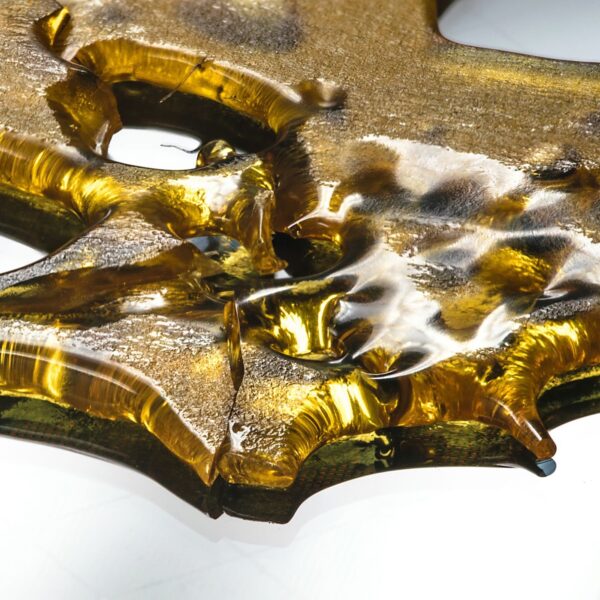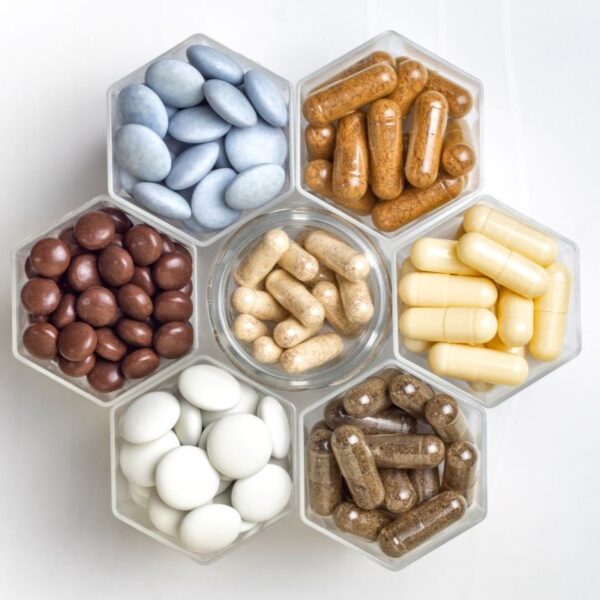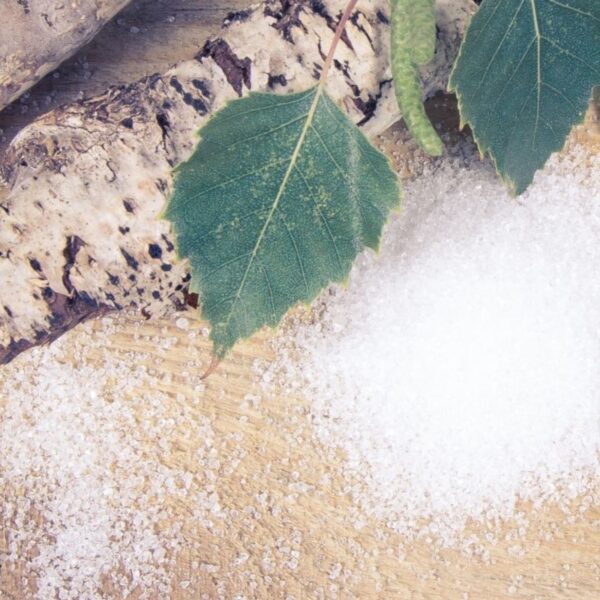Quercetin is a naturally occurring plant pigment and a polyphenol of the family of flavonoids in various fruits, vegetables, and grains. It is best known for its antioxidant properties. Quercetin cannot be produced in the human body, but it is commonly used in nutritional supplements and nutraceuticals due to its health-promoting properties.
What is Quercetin?
Quercetin, also known as sophoretin, is a polyphenol that belongs to the flavonol class of flavonoids. The chemical structure of quercetin contains three benzene rings (A, B, and C). It is a pentahydroxyflavone with five hydroxy groups placed in the 3-, 3′-, 4′-, 5-, and 7-positions.
Source: Wikipedia
How is Quercetin Produced?
Quercetin is one of the most abundant dietary flavonoids in citrus fruits, berries, green leafy vegetables, grains, seeds, and other foods such as olive oil and green tea.
The following table provides a sample of various foods along with their quercetin content as reported by the USDA:
| Food Source | Quercetin Content (mg/100g) |
| Raw onions | 13.27 |
| Black tea | 1.99 |
| Apple, with skin | 4.42 |
| Green tea | 2.69 |
| Broccoli, raw | 3.21 |
| Red wine | 0.84 |
| Spinach, raw | 4.86 |
| Cocoa powder, unsweetened | 20.1 |
| Cranberries, raw | 14 |
Quercetin is commercially produced by acid hydrolysis of rutin. The most common method is through boiling with diluted HCl. This process yields quercetin and the monosaccharides d-glucose and l-rhamnose. However, it’s important to note that boiling in a strong acid may partially decompose all reactants, affecting the purity and reducing the final product’s quality.
Properties of Quercetin
| Physical Form | Powder, crystals (Needles) |
| Color | Yellow |
| Storage Temperature & Conditions | Room temperature |
| Molecular Weight | 302.24 |
| Melting Point | 316.5°C |
| Boiling Point | 642.00-643.00°C |
| Refractive Index | 1.4790 |
| pKa | 6.31±0.40 |
| Log P | 1.48 |
| Solubility | Less than 1 mg/mL in water (~60 mg/L at 16°C) |
Quercetin Formulation Considerations
Stability
The chemical stability of quercetin is influenced by oxygen concentration, pH value, temperature, concentration of other antioxidants, and the presence of metal ions. The following table summarizes the stability of quercetin in various conditions:
| Thermal | 70% degradation at 100°C |
| Alkali/Acid | Complete degradation after 180 minutes at pH 8 |
| Metal Ions | Antioxidant activity is altered in the presence of chromium and tin metals ions |
Source: ScienceDirect
Bioavailability
Quercetin is poorly soluble in water, which affects its absorption in the small intestine. Its extensive metabolism in the liver and intestinal epithelium decreases its bioavailability by transforming it into metabolites with lower biological activity. Additionally, the intestinal microbiota can influence the absorption and metabolism of quercetin, further complicating its bioavailability. Due to poor solubility, quercetin’s oral bioavailability is estimated to be 1% in humans. A comparison of quercetin’s absorption in fat suggests that dietary fat can increase the absorption of quercetin.
Several strategies can improve the bioavailability of quercetin, including the following:
- In a study, quercetin-loaded Soluplus micelles were prepared using the co-solvent evaporation technique, which improved quercetin’s solubility profile. The bioavailability profile increased to 1676% compared to a pure drug solution.
- Researchers have also developed a variety of quercetin-involved nanoparticles (NPs) to address quercetin’s poor solubility and limited bioavailability.
- The potential of liposomes to enhance the bioactivity and bioavailability of quercetin has been the subject of several investigations. In one study, quercetin-loaded liposomes were trapped within chitosan microgels, which improved bioavailability.
- Oil-based micro and nanoemulsions have been used to improve the bioavailability of quercetin. The type of oil (triglyceride oils of either long-chain or medium-chain fatty acids) affects bio-accessibility and gastrointestinal stability.
- In a study, quercetin-loaded microgels made of pectin and oligochitosan had serum levels of quercetin approximately eight times higher than mice fed quercetin alone.
Biological Activity
| Antioxidant | – Quercetin’s antioxidant properties have been demonstrated to reduce power assay, DPPH, hydroxyl radicals, nitric oxide, hydrogen peroxide radicals, and superoxide. |
| Anti-inflammatory | – Quercetin can effectively be an antiviral agent against DENV-2 (Dengue). In a study, the IC50 and CC50 values for quercetin were reported to be 18.41 g/mL and 217.113 g/mL. – The effectiveness of quercetin against human T-lymphotropic virus 1 and Japanese encephalitis virus (JEV), which is responsible for the mosquito-borne illness Japanese encephalitis, has been well documented. – In another study, quercetin prevented the herpes simplex virus (as HSV-1, HSV-2, and drug-resistant HSV-1) from attaching to and infecting Madin-Darby canine kidney NBL-2 (MDCK) cells. |
| Antibacterial | – A study revealed that quercetin has strong bacteriostatic effect against a variety of bacterial species, including Helicobacter pylori, Salmonella enterica serotype Typhimurium, Micrococcus luteus, Yersinia enterocolitica, Pseudomonas aeruginosa, Escherichia coli, S. aureus, P. fluorescens, Campylobacter jejuni, and Staphylococcus epidermidis. – Quercetin has proven to be more effective against Gram-positive than Gram-negative bacteria. |
| Antifungal | – Quercetin has been found to reduce the biomass and metabolic activity in C. parapsilosis, C. metapsilosis, and C. orthopsilosis with 0.5 and 16 ug/mL MIC. – A study revealed that quercetin had the highest antifungal effects against Cryptococcus neoformans, Aspergillus niger, and Candida albicans. – In another study, quercetin caused higher concentrations of the genes encoding Rhogdp, calcium kinase, cAMP, Pkc, and Plc, highlighting its potential as an antifungal. |
| Antiviral | – The immunomodulating properties of quercetin have been effectively utilized in treating late-phase and late-late-phase bronchial asthma responses, allergic rhinitis, and restricted peanut-induced anaphylactic reactions. – Studies have shown that quercetin can reduce airway hyperresponsiveness, eosinophilic inflammation, and mucus hypersecretion. – Quercetin inhibits eosinophil activation, prompting a relaxation of the tracheal ring, decreased IL-4 and IgE serum levels, and blocked IL-8 and MCP-1 expression in airway epithelial cells. |
| Anti-allergenic | – Quercetin has been shown to inhibit histamine release, decrease pro-inflammatory cytokines and leukotrienes, and suppress interleukin IL-4 production. – Quercetin has been shown to reduce mast cell degranulation, attenuating the allergic response and potentially alleviating symptoms of allergies, such as itching, sneezing, and nasal congestion. – In a study, peanut-induced anaphylaxis responses were completely stopped after four weeks of regular quercetin consumption. |
| Anti-asthmatic | – Quercetin has been shown to inhibit histamine release, decrease pro-inflammatory cytokines and leukotrienes, and suppress interleukin IL-4 production. – Quercetin has been shown to reduce mast cell degranulation, attenuating the allergic response and potentially alleviating symptoms of allergies, such as itching, sneezing, and nasal congestion. – In a study, peanut-induced anaphylaxis responses were stopped entirely after four weeks of regular quercetin consumption. |
Absorption and Metabolism
| Absorption | – Quercetin metabolism occurs mainly in the gastrointestinal tract and the liver. The reconjugation process is a must for quercetin absorption. Reonjugation is caused by UDP-glucuronyltransferases (UGT), methylation by catechol O-methyltransferases (COMT), and sulfation by sulfotransferases (SULT). Quercetin glycosides not processed and absorbed by the small intestines are believed to be transported from the colon. – The colonic microflora expresses considerable L-rhamnosidase and b, D-glucosidase activity, allowing efficient deglycosylation of quercetin glycosides. – Gut microbiota carries out fission of the A- and B-ring of quercetin, leading to the formation of lower molecular weight phenolics. |
| Metabolism | – Quercetin metabolism occurs mainly in the gastrointestinal tract and the liver. The reconjugation process is a must for quercetin absorption. Reonjugation is caused by UDP-glucuronyltransferases (UGT), methylation by catechol O-methyltransferases (COMT), and sulfation by sulfotransferases (SULT). Quercetin glycosides not processed and absorbed by the small intestines are believed to be transported from the colon. – The colonic microflora expresses considerable a L-rhamnosidase and b, D-glucosidase activity, allowing efficient deglycosylation of quercetin glycosides. – Gut microbiota carries out fission of the A- and B-ring of quercetin, leading to the formation of lower molecular weight phenolics. |
| Excretion | – Quercetin undergoes phase II metabolism after absorption by the intestine and is finally excreted into bile through the liver or urine through the kidneys. |
Dosage form
Quercetin can be consumed orally for health benefits in the following forms:
- Tablet
- Capsule
- Oil suspensions
- Emulsified syrups
- Soft chews
Safety and Regulatory Considerations
| FDA Information | Quercetin has received the FDA GRAS (Generally Recognized As Safe) status for use as a dietary supplement. |
| EU Information | Quercetin (95%) derived from the pods and seeds of Dimorphandra mollis is listed under the “Novel Foods.” It falls under category (ii) (‘plant origin’) of Article 3(2) (a) of Regulation (EU) 2015/2283. |
Health Effects of Quercetin
| Cardioprotective | – Flavonoids exert antihypertensive, anti-atherosclerotic, antiplatelet activity, and positive effects against endothelial dysfunction, which may positively influence cardiovascular diseases. – In a study, red grape polyphenol extract, which is rich in quercetin, caused an increase in flow-mediated dilation of major arteries, an indicator of improved endothelial health. – Quercetin is known to exhibit a vasorelaxant effect on isolated arteries, lowering blood pressure and preventing the development of cardiac hypertrophy. It has also been shown to reduce the risk of mortality caused by low-density lipoprotein. – Quercetin has been shown to prevent LDL oxidation. |
| Anticancer | – Quercetin has potential anticancer properties, including antiproliferative, growth factor suppression, and antioxidant properties. – Quercetin functions as an apoptosis inductor and aids in decreasing the growth of malignant tumors in the brain, liver, colon, and other tissues. – In a study, a combined dosage of curcumin and quercetin reduced the number and size of ileal and rectal adenomas with minimal adverse effects. – Epidemiologic studies have demonstrated a negative association between quercetin intake and prostate cancer incidence and have suggested quercetin’s chemo-preventive effect on prostate cancer. |
| Hepatoprotective | – Flavonoids have been reported to modulate neuronal function and prevent age-related neurodegeneration. They have been shown to improve cognition function and protect vulnerable neurons by enhancing existing neuronal function or by stimulating neuronal regeneration. – Quercetin may improve cognitive ability against TMT-induced neuronal deficit and also have an inhibitory action against AchE. In a study demonstrated beneficial activities for neurodegenerative disorders, notably Alzheimer’s disease. – Quercetin has the potential to protect neurons against injury induced by neurotoxins. It can also produce changes in cerebrovascular blood flow, which can change neuronal morphology, causing neurogenesis and angiogenesis. |
| Neuroprotective | – Flavonoids have been reported to modulate neuronal function and prevent age-related neurodegeneration. They have been shown to improve cognition function and protect vulnerable neurons by enhancing existing neuronal function or by stimulating neuronal regeneration. – Quercetin may improve cognitive ability against TMT-induced neuronal deficit and also have an inhibitory action against AchE. In a study, demonstrated beneficial activities for neurodegenerative disorders, notably Alzheimer’s disease. – Quercetin has the potential to protect neurons against injury induced by neurotoxins. It can also produce changes in cerebrovascular blood flow, which can change neuronal morphology, causing neurogenesis and angiogenesis. |
| Anti-obesity | – Quercetin has a specific feature that inhibits fat accumulation in maturing human fat cells and simultaneously triggers apoptosis in existing fat cells. – Quercetin has been shown to inhibit adipocyte differentiation and adipogenesis. – Quercetin also blocks glucose uptake from the blood, blocks fat cell production, and enhances fat cell necrosis. |
| Anti-diabetes | One study demonstrated that higher quercetin consumption was correlated with a lower prevalence of type 2 diabetes mellitus in the adult population. |
Safety & Toxicity of Quercetin
Quercetin is generally considered safe. Numerous animal studies have consistently failed to demonstrate any relationship between quercetin administration and increased tumor
incidence. Several reviews have indicated that quercetin, although displaying mutagenic activity
in vitro, is not carcinogenic in vivo.
Identification Numbers
| IUPAC Name | 2-(3,4-dihydroxyphenyl)-3,5,7-trihydroxychromen-4-one |
| CAS Number | 117-39-5 |
| EC Number | 204-187-1 |
Acceptable Limits or Maximum Usage
Per the FDA, quercetin can be used as an ingredient in beverages and beverage bases, grain products and pasta, processed fruits and fruit juices, and soft candies at levels up to 500 milligrams per serving.
Fun Facts About Quercetin
- Quercetin’s name comes from the Latin word Quercetum, which means “oak forest.”
- Quercetin has been investigated for its potential to protect the skin from UV radiation damage. While it can’t replace traditional sunscreen, some research suggests it may help enhance the skin’s natural defense against UVB rays.
Additional Resources
- Quercetin: Its Role in the Prevention and Treatment of Chronic Diseases
- Design and Synthesis of Quercetin-Based Derivatives as Potential Antithrombotic Agents
- Quercetin: A Promising Molecule for COVID-19 Treatment
- Quercetin: A Flavonoid with Potential Therapeutic Effects on Diabetes
- Quercetin: A Promising Molecule for the Treatment of Cancer
- Quercetin: A Flavonoid with Potential Anti-Inflammatory Effects
- Quercetin: A Flavonoid with Potential Neuroprotective Effects
- Quercetin: NIH Compound








